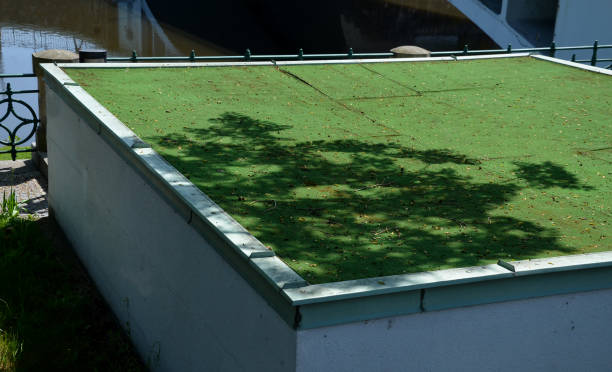When low spots develop on a flat roof, water can collect, continuing damage and causing water leaks in low-lying areas of the roof. With artificial turf, the area to be covered is leveled and braced to create a flat surface for proper drainage.
Adding artificial grass to flat roofs is a great way to make sheds, garages and outbuildings look brighter and more at home in the garden. Whether you're covering the common felt roof on your shed, or looking to update your roof deck or balcony, you'll get the best results if you follow our installer's guide to creating a faux grass roof.
Once you are fully equipped, you will need to select, measure and order your artificial turf prior to installation.
To calculate the amount of artificial turf you'll need to order for your green roof, measure the length and width of your roof, then multiply the two numbers to get the total surface area.
Make sure to allow at least 10cm of allowance in each direction to ensure a good fit and easy installation, otherwise you may struggle to achieve a professional finish.
Once you have your tools and artificial grass ready, you can start installing your artificial grass roof:
Make sure the roof you plan to cover is structurally sound and in good condition. Check to make sure it's not cracked or rotted, which could further damage the roof during installation.
If your roof is uneven, battened or tiled, installing a layer of planks, shock pads or underlayment can level the surface for an even finish.
Find out where the artificial grass needs to be cut to cover the entire roof, preferably on a piece of paper before you start cutting. Only when you're confident you've got it right can you start cutting the sod to size before putting it in place. When cutting artificial grass, be sure to cut along the lines of the drainage holes in the backing material, or your grass may start to unravel.
Once you are happy with the fit, fold the sod back along the edge where the sod meets each other so there is a gap between the two sods and the black backing material is facing up along the two sods.
Roll a strip of joint tape along the joint between the two grass pieces, glossy side down and sticky side up. Apply a thin layer of artificial grass adhesive along the length of the tape, then fold the grass down to secure the black backing to the glue and tape.
When you are satisfied with the installation and location of the artificial grass and that all connections between each piece are secure, roll the sod to one end and spread a bead of artificial grass adhesive evenly around the perimeter of the roof.
Carefully unroll the artificial turf, making sure the edges are properly aligned to the original dimensions. Lift the sod from the rolled-up edge above and apply a bead of adhesive along that edge, then press the sod back into place.
Once the adhesive is dry and your turf is firmly set, give it a quick brush with a bristle brush to lift the mound and remove any flattened grass.
After a few hours, your artificial grass roof will be firmly in place and looking fresh, green and natural. Now you can relax and enjoy your craft without the hassle of maintaining a natural green roof



Share:
Why an Artificial Grass Lawn is Perfect for A Party?
Is artificial turf the best choice for a small patio?